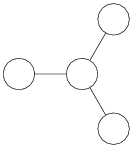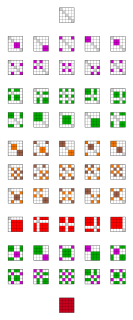In mathematics, especially in abstract algebra, a quasigroup is an algebraic structure resembling a group in the sense that "division" is always possible. Quasigroups differ from groups mainly in that they are not necessarily associative.
In mechanics and geometry, the 3D rotation group, often denoted SO(3), is the group of all rotations about the origin of three-dimensional Euclidean space R3 under the operation of composition. By definition, a rotation about the origin is a transformation that preserves the origin, Euclidean distance, and orientation. Every non-trivial rotation is determined by its axis of rotation and its angle of rotation. Composing two rotations results in another rotation; every rotation has a unique inverse rotation; and the identity map satisfies the definition of a rotation. Owing to the above properties, the set of all rotations is a group under composition. Rotations are not commutative, making it a nonabelian group. Moreover, the rotation group has a natural structure as a manifold for which the group operations are smoothly differentiable; so it is in fact a Lie group. It is compact and has dimension 3.
In mathematics, a Lie superalgebra is a generalisation of a Lie algebra to include a Z2-grading. Lie superalgebras are important in theoretical physics where they are used to describe the mathematics of supersymmetry. In most of these theories, the even elements of the superalgebra correspond to bosons and odd elements to fermions.

In mathematics and theoretical physics, the term quantum group denotes various kinds of noncommutative algebras with additional structure. In general, a quantum group is some kind of Hopf algebra. There is no single, all-encompassing definition, but instead a family of broadly similar objects.

In transcendental number theory, the Lindemann–Weierstrass theorem is a result that is very useful in establishing the transcendence of numbers. It states the following.
In algebraic geometry, motives is a theory proposed by Alexander Grothendieck in the 1960's to unify the vast array of similarly behaved cohomology theories such as singular cohomology, de Rham cohomology, etale cohomology, and crystalline cohomology. Philosophically, a 'motif' is the 'cohomology essence' of a variety.

In mathematics, SO(8) is the special orthogonal group acting on eight-dimensional Euclidean space. It could be either a real or complex simple Lie group of rank 4 and dimension 28.
In commutative algebra and field theory, the Frobenius endomorphism is a special endomorphism of commutative rings with prime characteristic p, an important class which includes finite fields. The endomorphism maps every element to its p-th power. In certain contexts it is an automorphism, but this is not true in general.

In linear algebra, a basis for a vector space of dimension n is a set of n vectors (α1, …, αn), called basis vectors, with the property that every vector in the space can be expressed as a unique linear combination of the basis vectors. The matrix representations of operators are also determined by the chosen basis. Since it is often desirable to work with more than one basis for a vector space, it is of fundamental importance in linear algebra to be able to easily transform coordinate-wise representations of vectors and operators taken with respect to one basis to their equivalent representations with respect to another basis. Such a transformation is called a change of basis.

In probability theory and statistics, the inverse gamma distribution is a two-parameter family of continuous probability distributions on the positive real line, which is the distribution of the reciprocal of a variable distributed according to the gamma distribution. Perhaps the chief use of the inverse gamma distribution is in Bayesian statistics, where the distribution arises as the marginal posterior distribution for the unknown variance of a normal distribution, if an uninformative prior is used, and as an analytically tractable conjugate prior, if an informative prior is required.
In mathematics, the interior product is a degree −1 (anti)derivation on the exterior algebra of differential forms on a smooth manifold. The interior product, named in opposition to the exterior product, should not be confused with an inner product. The interior product ιXω is sometimes written as X ⨼ ω.
In mathematics, a compact quantum group is an abstract structure on a unital separable C*-algebra axiomatized from those that exist on the commutative C*-algebra of "continuous complex-valued functions" on a compact quantum group.
Any vector space can be made into a unital associative algebra, called functional-theoretic algebra, by defining products in terms of two linear functionals. In general, it is a non-commutative algebra. It becomes commutative when the two functionals are the same.
We take the functional theoretic algebra C[0, 1] of curves. For each loop γ at 1, and each positive integer n, we define a curve called n-curve. The n-curves are interesting in two ways.
- Their f-products, sums and differences give rise to many beautiful curves.
- Using the n-curves, we can define a transformation of curves, called n-curving.

The Kelvin–Stokes theorem, named after Lord Kelvin and George Stokes, also known as the Stokes' theorem, the fundamental theorem for curls or simply the curl theorem, is a theorem in vector calculus on . Given a vector field, the theorem relates the integral of the curl of the vector field over some surface, to the line integral of the vector field around the boundary of the surface.
A Representation up to homotopy is a concept in differential geometry that generalizes the notion of representation of a Lie algebra to Lie algebroids and nontrivial vector bundles. It was introduced by Abad and Crainic.
In mathematics, Ricci calculus constitutes the rules of index notation and manipulation for tensors and tensor fields. It is also the modern name for what used to be called the absolute differential calculus, developed by Gregorio Ricci-Curbastro in 1887–1896, and subsequently popularized in a paper written with his pupil Tullio Levi-Civita in 1900. Jan Arnoldus Schouten developed the modern notation and formalism for this mathematical framework, and made contributions to the theory, during its applications to general relativity and differential geometry in the early twentieth century.
In algebraic topology, the path space fibration over a based space is a fibration of the form
This article summarizes important identities in exterior calculus.



























